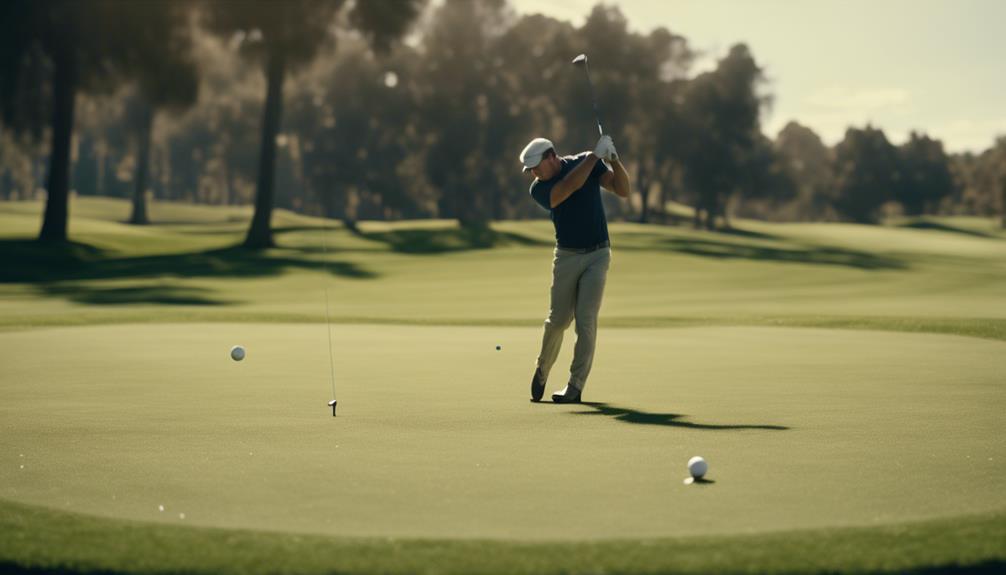- 7 Top Flite Golf Clubs XL for Improved Performance - September 28, 2024
- Top Flite Golf Clubs: Top 5 Reasons to Choose Them - September 28, 2024
- Top 3 Golf Club Fitters for a Perfect Swing - September 28, 2024
When choosing the right flex for your golf clubs, it's essential to think about your swing speed, driving distance, grip pressure, and overall comfort. If your shaft flex is too stiff, you may struggle to generate power and control, while a flex that's too flexible can lead to a loss of accuracy and consistency. Measure your swing speed using a launch monitor or radar gun, and use your driving distance to determine the ideal flex. Then, take into account factors like grip pressure, torque, and kick point to find the perfect feel and performance. Now, discover the ideal flex combination that will take your game to the next level.
Key Takeaways
- Correct shaft flex is crucial for a smoother, more consistent swing, as it influences club head speed and swing dynamics.
- Measuring swing speed and driving distance helps determine the ideal shaft flex, with average male and female swing speeds being around 85-90 mph and 60-70 mph, respectively.
- Factors like grip pressure control, torque, and kick point impact shaft flex selection, and finding the right combination is essential for comfort and performance.
- Choosing the wrong shaft flex can lead to inconsistent ball flight, reduced distance and accuracy, and poor overall performance, making custom fitting essential.
- Using shaft length and flex charts helps determine the ideal combination for the game, ensuring the best possible performance from golf clubs.
Understanding Golf Shaft Flex
When selecting golf clubs, you'll encounter various shaft flex options, but to make an informed decision, you need to understand how shaft flex affects your game.
The correct golf shaft flex is crucial, as it directly impacts the performance of your golf club shafts. Shaft flex refers to the degree of flexibility in the golf shaft, which influences the club head speed and overall swing dynamics.
Choosing the right flex is critical, as it ensures a smoother, more consistent swing. If your shaft flex is too stiff, you may struggle to generate power and control.
Conversely, a shaft that's too flexible can result in a loss of accuracy and consistency. To determine the ideal shaft flex, consider your club head speed, swing tempo, and personal playing style.
A flex that's right for you'll help you achieve a more efficient transfer of energy from the shaft to the ball, resulting in better shots and improved overall performance. By understanding golf shaft flex, you'll be better equipped to choose the right shaft for your game, unlocking your full potential on the course.
Measuring Your Swing Speed
Frequently, golfers rely on launch monitors or radar guns to accurately measure their swing speed, which provides a essential benchmark for selecting the right shaft flex.
These devices can give you a precise reading of your ball speed and club head speed.
However, if you don't have access to these tools, you can estimate your swing speed by measuring your driving distance.
A general rule of thumb is that your swing speed is approximately 2.3 times your average driving distance.
According to the PGA, your swing speed can categorize you as a touring professional, advanced golfer, mid-handicapper, or beginner.
Swing speed is typically measured in miles per hour (mph), with the average male golfer's swing speed being around 85-90 mph, and the average female golfer's swing speed being around 60-70 mph.
To get an accurate measurement, take an average of multiple swings, as swing speed can vary slightly from swing to swing.
Knowing your swing speed will help you choose the right shaft flex, which is fundamental for peak performance.
Determining Your Driving Distance

Measuring your driving distance is a crucial step in determining your swing speed, as it provides a reliable indicator of your overall power and tempo.
To determine your driving distance, measure the average distance you hit your driver on a consistent basis, taking into account factors like course conditions and wind.
A general guideline is to use your best shots from the past 10-20 rounds to get an accurate average driving distance.
If you don't have access to tracking data, you can estimate your driving distance by considering your handicap, swing speed, and ball flight characteristics.
For men, a driving distance of 220-250 yards is considered average, while for women, it's around 150-180 yards.
Keep in mind that driving distance can vary depending on the specific club and ball used, as well as the individual's swing technique and style.
Feeling and Comfort Matters
As you consider the right flex for your golf clubs, you'll want to pay attention to grip pressure control and shaft flex feel.
These two factors can greatly impact your overall comfort and performance on the course.
Grip Pressure Control
Controlling your grip pressure is essential to finding the perfect flex for your golf clubs, as it directly impacts the feel and comfort of the club in your hands throughout the swing.
If you have a tight grip pressure, you may benefit from a stiffer shaft to counteract the added torque. On the other hand, if you have a light grip pressure, you may prefer more flexible shafts for increased feel and control.
The ideal grip pressure is around 10-12 pounds, allowing for a smooth, controlled swing without restricting the club's motion.
Golfers with high grip pressures often struggle with slice and hook shots, as the added torque causes the clubface to close or open prematurely.
You can measure your grip pressure using a grip pressure gauge, which provides a numerical reading to help determine the ideal flex shaft for your swing.
Shaft Flex Feel
When you grip a golf club, the shaft flex feel should provide a sense of comfort and responsiveness, allowing you to maintain a smooth tempo and rhythm throughout your swing.
This feeling is vital, as it directly impacts your overall performance. A shaft with the right flex might make a significant difference in your game.
If you're a golfer with moderate swing speed, a regular flex shaft is likely suitable for you.
However, if you have a faster swing speed, stiff shafts or even extra stiff flex might be more suitable.
You must also think about your shaft length, as it affects the overall feel and responsiveness of the club.
A properly fitted set of clubs with the right shaft flex will help you maintain a consistent swing tempo and rhythm.
You'll be able to generate more power and control, resulting in better shots.
Using Shaft Length and Flex Charts

As you explore the world of golf club flex, bear in mind that evaluating the importance of shaft length and flex charts is crucial.
You'll need to take precise measurements, from the wrist crease to the floor, to determine your ideal shaft length, which can range from 37 to 39 1/2 inches depending on your height.
Shaft Length Measurements
Measuring your shaft length accurately is critical, since it directly impacts your swing's effectiveness, and using a shaft length and flex chart helps you determine the ideal combination for your game. To measure your shaft length, stand tall and measure from the wrist crease to the floor. This will give you a measurement ranging from 37 inches to 39 1/2 inches, which corresponds to different shaft lengths. A slight miscalculation can result in significant losses, such as a 0.5-inch off-centre impact leading to a 7% loss of carry distance.
Here's a sample shaft length and flex chart to guide you:
| Height Range | Recommended Shaft Length | Flex Type |
|---|---|---|
| 5'6" to 5'9" | 38.5" to 39" | Regular |
| 5'10" to 6'1" | 39" to 39.5" | Stiff |
| 6'2" to 6'4" | 39.5" to 40" | Senior |
| 6'5" and above | 40" and above | Extra Stiff |
Flex Rating Explained
By correlating your swing speed to the appropriate stiffness, you can use a shaft flex chart to determine the ideal flex rating for your golf clubs, ensuring a more precise fit and improved performance on the course.
This chart helps you find the right golf shaft by matching your swing speed to the corresponding shaft flex rating. For instance, if you have faster swing speeds above 105 mph, you'll need an X-stiff shaft, while those with slower swing speeds between 84-96 mph will benefit from a Regular flex.
If you're a senior golfer or a lady golfer, you may require a Senior flex or ladies flex, respectively. Understanding these flex ratings is vital, as they've a profound impact on your game.
A shaft flex chart simplifies the club selection process, providing a more accurate fit. With the right flex, you'll experience improved accuracy and performance on the course.
Considering Shaft Technology and Torque
When selecting a golf club shaft, you'll want to explore the specifics of shaft technology and torque to guarantee the right fit for your swing.
Shaft technology has come a long way, and understanding its nuances can make a significant difference in your game.
Graphite shafts, for instance, are known for their lighter weight and increased flexibility, which can result in higher ball speeds and longer drives.
However, they may not provide the same level of control as steel shafts.
Torque, on the other hand, refers to the twisting force that occurs during the swing.
A shaft with less torque will provide a more consistent and stable feel, while a shaft with higher torque may result in a more dynamic swing.
The kick point, where the shaft flexes the most, also plays a vital role in determining the correct shaft for your swing.
A stiffer shaft will have a lower kick point, while a more flexible shaft will have a higher kick point.
Avoiding the Wrong Flex Choice

If you're not careful, selecting the wrong shaft flex can lead to a multitude of issues that will hinder your golf game, including inconsistent ball flight, reduced distance, and a lack of control. This can be frustrating, especially when you're trying to improve your game.
Inconsistent ball flight: A shaft that's too stiff or too flexible can cause the ball to fly erratically, making it difficult to hit consistent shots.
Reduced distance and accuracy: If your shaft flex is too weak, you'll lose distance and struggle to hit the ball straight. On the other hand, a shaft that's too stiff can result in a loss of control and accuracy.
Poor overall performance: The wrong shaft flex can affect your entire golf game, leading to a lack of confidence and consistency. This can be especially true when buying clubs, as a wrong flex choice can make even the best golf clubs feel unplayable.
Getting Custom Fitted for Success
To guarantee the right flex for your golf clubs, consider getting custom fitted, a process that takes into account your unique swing characteristics to optimize performance. This process involves working with a professional fitter who will analyze your swing speed, ball flight, and shot pattern to determine the ideal shaft flex for you.
| Factor | Description | Impact on Flex |
|---|---|---|
| Swing Speed | Measures how fast you swing | Faster swings require stiffer flex, slower swings require more flexible flex |
| Ball Flight | Examines the trajectory of your shots | Higher shots require more flexible flex, lower shots require stiffer flex |
| Shot Pattern | Analyzes the direction and dispersion of your shots | Inconsistent patterns require more flexible flex, consistent patterns require stiffer flex |
| Swing Style | Assesses your overall swing mechanics | Aggressive swings require stiffer flex, smooth swings require more flexible flex |
| Body Type | Considers your physical attributes | Larger or stronger players require stiffer flex, smaller or weaker players require more flexible flex |
Frequently Asked Questions
How to Choose Flex for Golf Clubs?
When selecting a flex, you'll consider flex options based on your swing speed, club head speed, and desired ball flight, factoring in shaft material, flex rating, player style, and golfer profile to optimize performance.
How Do You Know What Shaft Is Right for You?
"As you step onto the green, envision your perfect swing; now, find your ideal shaft through testing, considering swing tempo, ball flight, and club fitting tailored to your body type, swing style, hand strength, and personal preference."
What Is the Difference Between 5.5 and 6.0 Flex?
When comparing 5.5 and 6.0 flex shafts, you'll notice differences in swing style, club head speed, and tempo, with 6.0 providing a slightly longer shot and lower ball flight, while 5.5 offers more forgiveness and a higher trajectory.
Do I Need Stiff or Regular Flex?
Considering your swing speed, stiff lofts might suit you if you can maintain control, but if you prioritize club distance, regular flex options might be a better fit, depending on your shaft weight, ball flight, and overall swing style and player profile.
Conclusion
You've got the keys to discovering your peak golf game – now it's time to put them into practice!
Remember, choosing the right flex is like finding the missing piece of a puzzle; it completes the picture, allowing you to swing with precision and power.
Don't let the wrong flex hold you back – get fitted, feel the difference, and watch your game soar to new heights.




